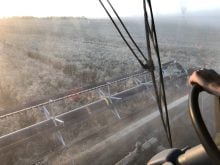He had to sit in the hallway, watching a malfunctioning TV feed while people continually walked in front of him.
But Swift Current, Sask., farmer Dennis Wieler was determined to be part of the Crop Production Week’s pulse meeting, even if he and 100 other producers couldn’t get into the meeting room.
“It’s the only commodity that pays at all, that even comes close to meeting the expense,” said Wieler, explaining why so many fellow farmers had shown up for the meeting.
“You have no other choice.”
Read Also

U.S. bill could keep out Canadian truckers
The Protecting America’s Roads Act, which was tabled in the U.S. House of Representatives at the beginning of October, would “rid the country of illegal immigrant commercial truck drivers and ineligible foreign nationals.”
More than 1,100 farmers were inside the Saskatoon Inn’s main ballroom and the adjoining conference rooms whose walls had been opened to accommodate the crowd.
About 100 more had to stand in the hallway, listening to the proceedings on TV or peering through the doorways at the distant stage.
Inside the room, bean, chickpea and lentil experts from Saskatchewan, Manitoba and Australia discussed production problems and solutions.
Manitoba Pulse Growers executive manager Ken Tjaden seemed overwhelmed by the titanic turnout of pulse growers, and wondered what the effect would be for his province’s growers if Saskatchewan farmers kept increasing production.
Manitoba pulse production has been rocketing higher in the past few years, particularly after the sugar beet industry collapsed.
The main bean grown in Manitoba is the navy bean, which went from 44,890 acres in 1998 to 111,371 acres in 1999 and is expected to be planted on 185,000 acres this spring.
Garth Patterson, the executive director of the Saskatchewan Pulse Growers association, said in an interview that the pulse bubble shows no signs of bursting. Nine times as much pulse acreage was planted in Saskatchewan last year as in 1989, increasing from 380,000 acres to 3.25 million.
There is intense interest in chickpeas, and no sign that producers intend to stop expanding acres, Patterson said.
“Pulses have a reputation of being profitable,” he said.

















